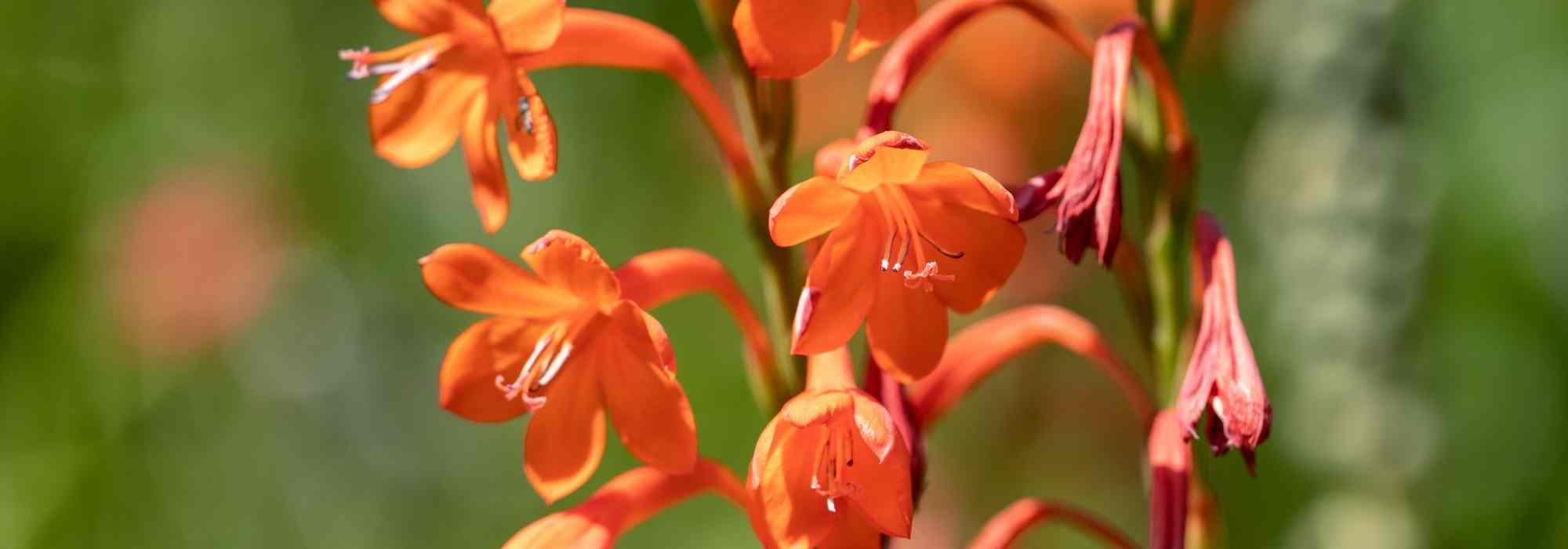
Watsonia: planting, care
Contents
Watsonia in a nutshell
- Watsonia is a hardy bulbous perennial perfectly suited to mild climates
- In colder regions, it is advisable to lift the bulbs in autumn to store them in a frost-free place for winter, and to bring them out again in spring
- It bears spikes of star-shaped flowers in orange, pink, or white, rising above sword-shaped foliage
- It requires rich soil that remains cool and well-drained, along with regular watering
- It can be used in borders, beds, or in pots on the terrace or balcony
A word from our expert
Watsonia is a perennial bulbous plant that forms a clump of long, sword-shaped leaves topped with trumpet-shaped flowers in pink, white, orange, or red, blooming in spring or summer depending on the variety.
Among the cultivars or hybrids derived from watsonia borbonica (syn. W. pyramidata) with pink flowers and Watsonia meriana, Watsonia ‘Peach Glow’ is one of the most popular.
Tender, it should be reserved for open ground in mild climates, but elsewhere, growing it in pots to bring indoors during winter is easy. It grows well like gladioli, which are lifted after the foliage has yellowed, to be replanted the following spring.
It prefers a warm, partially shaded location and rich, cool, lime-free soil.
Alongside kniphofias or other summer perennials, it will add a bright and exotic touch to borders in the garden or on the terrace.
Discover this beautiful, highly graphic bulb, ideal for adding verticality and colour!
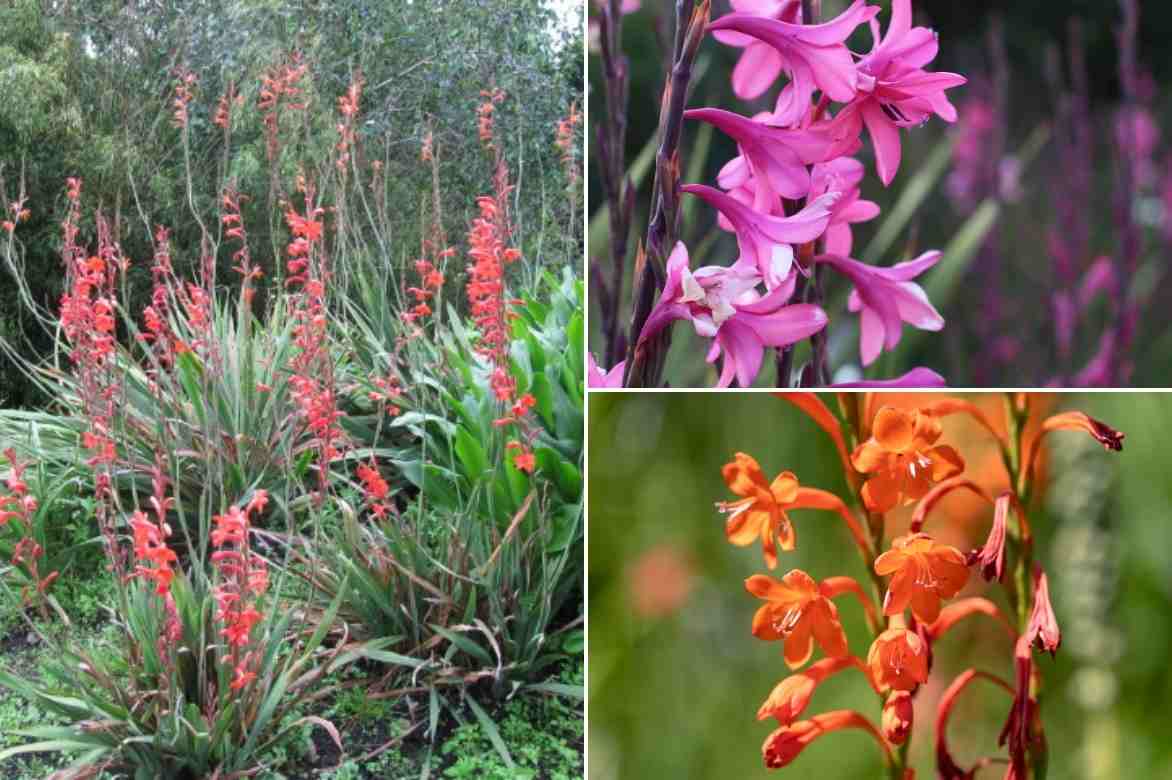
The remarkable flowering of Watsonia (Photo: L. Enking)
Botany
“`html
Botanical data
- Latin name Watsonia
- Family Iridaceae
- Common name Watsonia, bugle lily
- Flowering May to August depending on varieties
- Height 0.45 to 1.50 m
- Exposure Sun, Partial shade
- Soil type well-drained, moist
- Hardiness -5-7°C
Watsonia is a bulbous plant with low hardiness belonging to the Iridaceae family, like Crocosmias, Gladioli, Irises, and Schizostylis. From its South African origins, it retains a preference for warmth but has a congenital sensitivity to cold! It is very sensitive to frost, and it is obligatory to winter its bulbs or corms in most of our regions to replant them in spring, as they do not withstand temperatures below -5–8°C. This is a semi-hardy plant that is easy to cultivate in pots or under the mild winters of Brittany or the Mediterranean climate.
The genus comprises about fifty species, including the Watsonia borbonica (syn. W. pyramidata), which is the most common in our gardens. The species Watsonia meriana has given rise to a series of interesting cultivars. Many horticultural hybrids have also emerged. The Watsonia pillansii is the hardiest of the Watsonias, tolerating temperatures down to -15°C.
The Watsonia forms elegant clumps measuring from 40 cm to over 1 m high from fibrous corms that multiply by producing new underground bulblets. Each corm produces 3-4 leafy stems. The narrow leaves emerge from the base and fan out to form a beautiful spreading clump, which only persists in mild climates and moist soil. They are linear, 50-80 cm long, 2 to 4 cm wide, and sword-shaped, similar to those of Gladioli. Pointed like swords, medium green, glossy, they are marked by numerous parallel veins.
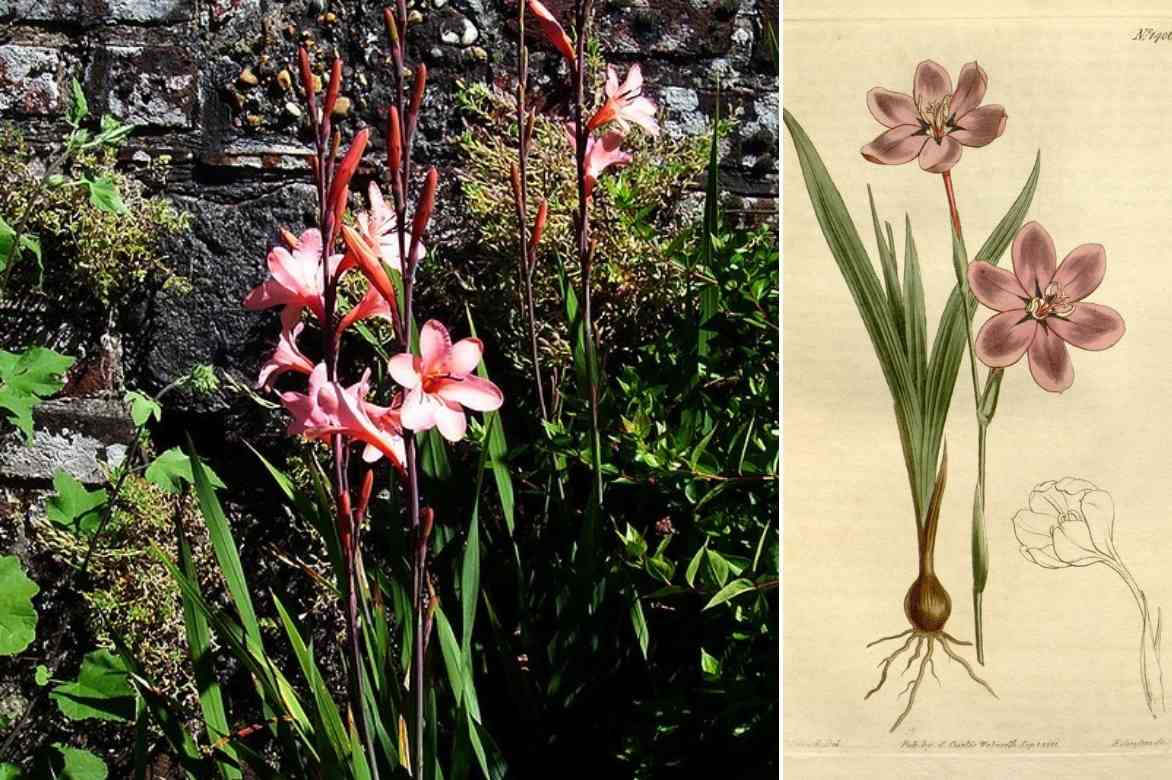 Inflorescence (Photo: Peganum) and botanical plate from 1811[/caption>
Inflorescence (Photo: Peganum) and botanical plate from 1811[/caption>
The very graphic and elegant flowering of the Watsonia never goes unnoticed. Between April and August, the sturdy, unbranched flower stems emerge from this dense clump, rising quickly to sometimes over 1.50 m above the ground. They end with long, very upright terminal spikes of flowers, branched in a zigzag pattern. The flower buds open from the bottom to the top of the spike. Each spike contains between 10 and 25 alternate flowers, regularly arranged along the stems. The flowers are elongated, funnel-shaped, with tepals forming a long, slender floral tube that curves to the horizontal. They measure 4-5 cm long and consist of 6 tepals with rounded or pointed tips. The corollas feature 3 prominent stamens, a characteristic of the Iridaceae.
These small trumpet-shaped flowers come in a palette of always very bright colours, from the softest to the most vivid, ranging from bright pink, peach, coral, or salmon, to white, cream, orange, and more rarely red.
The highly structured flowering is ephemeral, lasting only 4 to 5 weeks, but it is particularly melliferous, irresistibly attracting bees.
The flowers are perfect for somewhat sophisticated bouquets.
They give way to fruits in the form of dehiscent capsules containing seeds that can be collected for sowing. They retain their germinative properties for up to 5 years.
Like Gladiolus, Watsonia has a bulb, which is actually a corm: a sort of rounded and flattened bulb surrounded by a fibrous tunic. The corm, which serves as a storage and reproduction organ, depletes during flowering, then produces one to three other corms just above, which replace the old one, ensuring the plant’s reproduction.
“`
Read also
10 summer bulbs to plant in springMain species and varieties
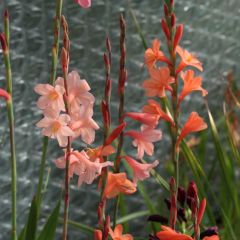
Watsonia pyramidata Peach Glow
- Flowering time June to August
- Height at maturity 1,30 m
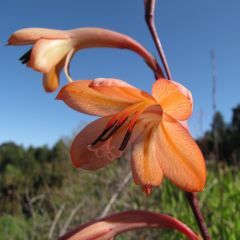
Watsonia meriana
- Flowering time August, September
- Height at maturity 60 cm
Discover other Watsonia
View all →Available in 1 sizes
Available in 1 sizes
Available in 2 sizes
Available in 1 sizes
Available in 1 sizes
Planting
Where to plant Watsonia?
Semi-hardy (down to -8°C), Watsonia is only easily grown in open ground in Mediterranean climates or along the Atlantic coast. If you live in a cold climate where temperatures frequently drop below -10°C, it is better to dig up the corm in autumn and bring it into a frost-free shelter to replant in spring. In mild climates, winter protection is not necessarily required. If the garden soil is not too wet in winter, you can leave them in the ground and, if needed, protect them with a dry mulch. No matter where you are, it will create beautiful, structured, and colourful pots on the terrace or balcony!
If your climate allows you to attempt growing it in open ground, it should be placed in full sun or in a spot that is shaded for part of the day in summer, and protected from strong winds. To prevent the corms from rotting, it is important to grow them in a light, well-draining substrate. However, the soil must remain cool in summer as it needs water during the growing season. Watsonia prefers sandy, slightly acidic soils. It dislikes heavy, wet, calcareous soils. It appreciates fertile soils rich in organic matter.
In overly heavy soil, planting on a sand dune, in a rock garden, or on a slope will work very well. Watsonia bulbs will flower along the edges of borders or paths, on slopes, or in mixed borders, adding elegance, volume, and lightness!
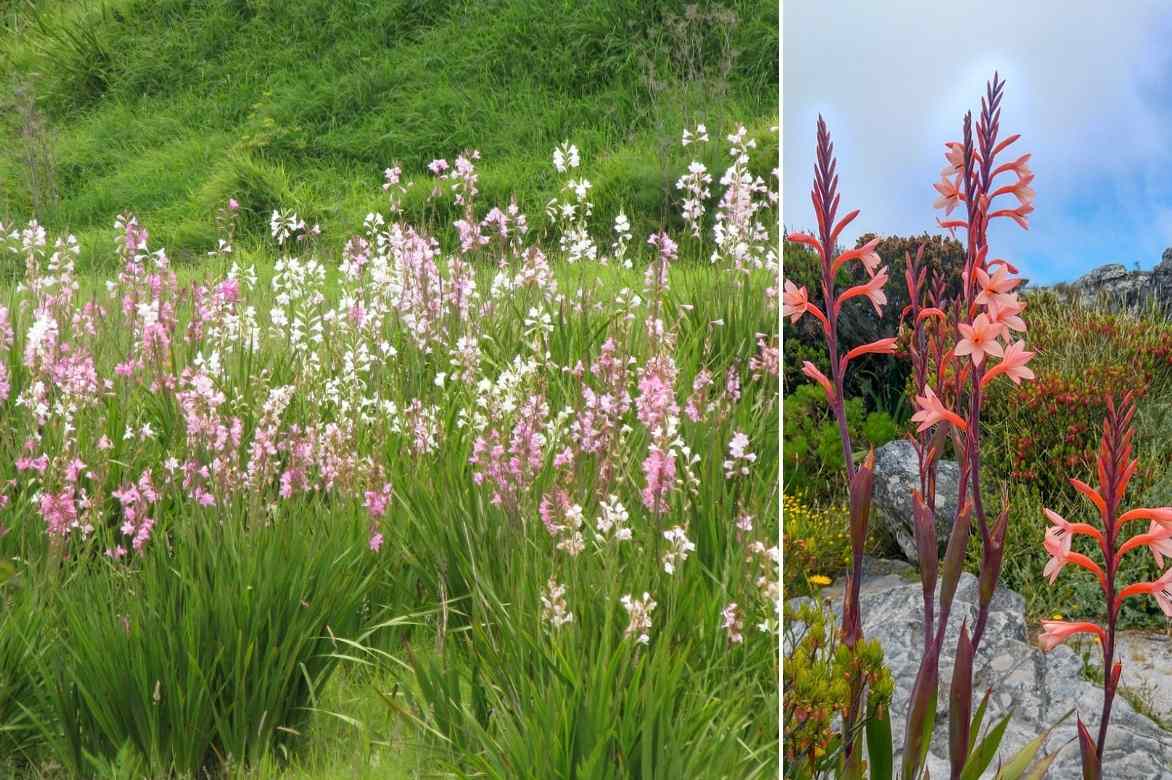 Watsonia enjoys well-draining soils and bright situations (Photos: F.K Starr and M. Smith)
Watsonia enjoys well-draining soils and bright situations (Photos: F.K Starr and M. Smith)
When to plant it?
Watsonia is planted in spring, from March-April until May. In mild climates, it can be planted in autumn, flowering early in spring.
How to plant it?
In open ground
If your soil is clayey and compact, it is essential to improve it by adding coarse sand or gravel.
- Loosen the soil over at least one spade’s length to aerate it
- Using a bulb planter, dig a hole
- Add a bit of coarse sand at the bottom, or clay balls for drainage
- Mix the soil with river sand to maximise drainage
- Plant the corms 6-8 cm deep, point upwards, spacing them about 10-15 cm apart
- Cover the bulbs with soil and firm down
- Water
In a pot
- Spread a good layer of drainage material, such as clay balls or gravel, at the bottom of a pot at least 20 cm in diameter and depth.
- Plant 5 corms (you will need 10 in a pot 30-35 cm in diameter), point upwards, in a mix of 50% potting soil and 50% river sand
- Firm down and water
Care
In the ground
Watsonia requires regular watering during flowering. In summer, water once a week during growth if the soil is very dry. At the end of flowering, it is advisable not to water when the plant enters dormancy. If you live in a region with a mild climate, leave the bulbs in the ground for winter. Do not cut the foliage until it has completely yellowed. This allows the plant to replenish its reserves in the corm before entering rest to bloom again the following year.
Watsonia is not very susceptible to diseases.
It prefers rich soils: apply well-decomposed compost on the surface in early spring. If you live in a cold climate, you will need to dig up the bulbs in autumn to protect them from frost. Wait until the foliage has turned yellow and dry, then dig up the corms, remove the soil, and cut the stems and leaves. Store the bulbs in a box and cover them with a layer of turf. Keep them in a dry, airy, cool place (between 2 and 10 °C), frost-free and protected from rodents. You can replant them in spring.
Divide the clumps every 4 to 5 years, as over time, tightly packed corms become less floriferous.
In pots
Keep the substrate moist throughout the growing season but never allow water to stagnate in the saucers: water once to three times a week.
Top-dress in spring or autumn with a low-nitrogen fertiliser; a little compost or potting soil.
As winter approaches, mulch the corms and store the pot in a frost-free place in a cool room or a cold greenhouse. If this is not possible, dig up the bulbs and store them frost-free.
Multiplication
Corms can be divided; this is the simplest method. Do this every 4 to 5 years. Around the corm, watsonia produces small bulbets that can be detached and replanted elsewhere to multiply the plant. Sowing is also possible by planting the seeds in spring in a moist sandy substrate kept at 25°C. They will take 4 years to flower. It is easier and quicker to separate the corms!
Division
- In autumn, remove the root ball and then, using a sharp and well-disinfected knife, separate the corms
- Store them for winter in a box filled with sand or turf
- Replant in the following spring in well-prepared and enriched soil or in pots
- Water well after planting
- The bulbets will flower after 2-3 years
Pairing ideas
Watsonias are interesting for creating original and very colourful scenes. They are best planted in groups in the medium or background of a sunny border. Their very upright habit adds verticality, colour, and dynamism to the borders. With their highly graphic appearance, they pair perfectly with other large, majestic, and/or exuberant flowers, such as Asian lilies, gladioli, dahlias, gaura, and echinacea.
Because they have a rigid habit, we recommend planting them alongside some clumps of grasses like Chinese fountain grass, which are more flexible and airy.
For a more exotic feel, mix Watsonia with Kniphofias, crocosmias, cannas, and Carex.
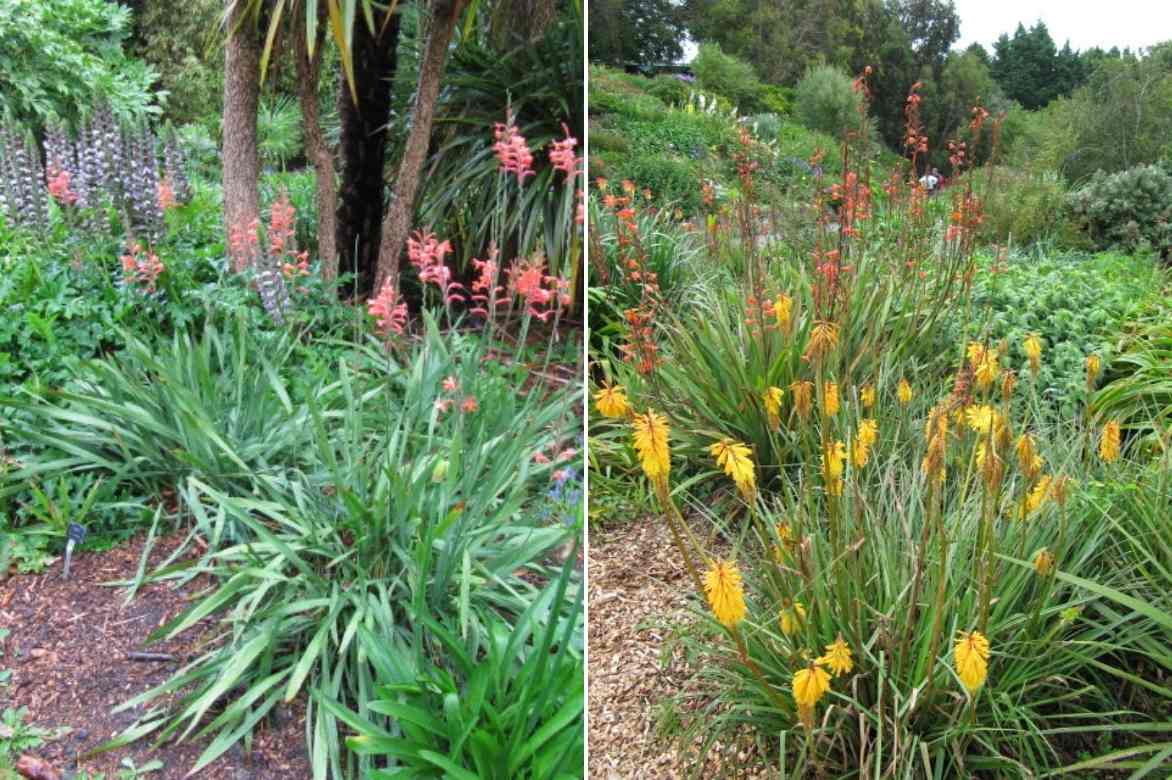
Watsonias, very elegant when accompanied by Acanthus or Kniphofias (Photos: L. Enking)
→ Discover more association ideas with Watsonia in our article!
Useful resources
- Potted plants and watering: managing the heat during your absence
- Subscribe!
- Contents































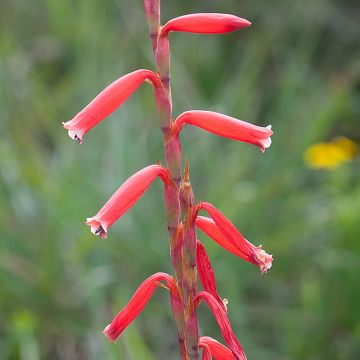


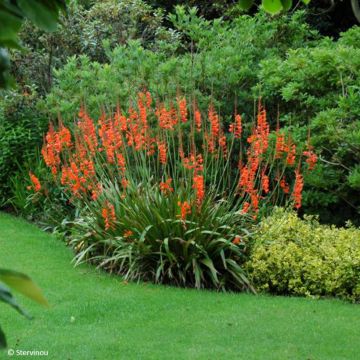
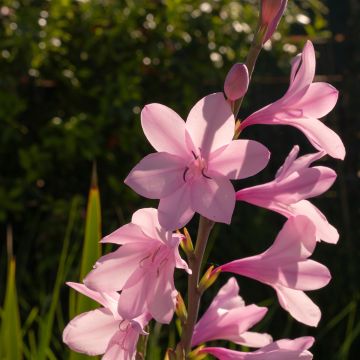
Comments